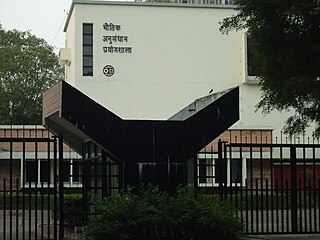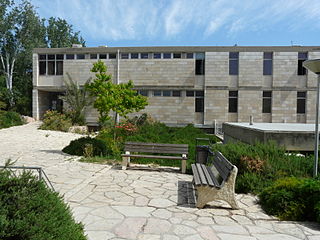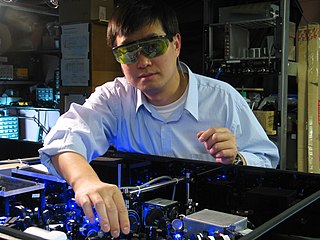Atomic physics is the field of physics that studies atoms as an isolated system of electrons and an atomic nucleus. Atomic physics typically refers to the study of atomic structure and the interaction between atoms. It is primarily concerned with the way in which electrons are arranged around the nucleus and the processes by which these arrangements change. This comprises ions, neutral atoms and, unless otherwise stated, it can be assumed that the term atom includes ions.
The following outline is provided as an overview of and topical guide to physics:
Atomic, molecular, and optical physics (AMO) is the study of matter–matter and light–matter interactions, at the scale of one or a few atoms and energy scales around several electron volts. The three areas are closely interrelated. AMO theory includes classical, semi-classical and quantum treatments. Typically, the theory and applications of emission, absorption, scattering of electromagnetic radiation (light) from excited atoms and molecules, analysis of spectroscopy, generation of lasers and masers, and the optical properties of matter in general, fall into these categories.
Quantum optics is a branch of atomic, molecular, and optical physics dealing with how individual quanta of light, known as photons, interact with atoms and molecules. It includes the study of the particle-like properties of photons. Photons have been used to test many of the counter-intuitive predictions of quantum mechanics, such as entanglement and teleportation, and are a useful resource for quantum information processing.

Lene Vestergaard Hau is a Danish physicist and educator. She is the Mallinckrodt Professor of Physics and of Applied Physics at Harvard University.
The Max-Planck-Institut für Kernphysik is a research institute in Heidelberg, Germany.

The Physical Research Laboratory is a National Research Institute for space and allied sciences, supported mainly by Department of Space, Government of India. This research laboratory has ongoing research programmes in astronomy and astrophysics, atmospheric sciences and aeronomy, planetary and geosciences, Earth sciences, Solar System studies and theoretical physics. It also manages the Udaipur Solar Observatory and Mount Abu InfraRed Observatory. The PRL is located in Ahmedabad.

Atomic astrophysics is concerned with performing atomic physics calculations that will be useful to astronomers and using atomic data to interpret astronomical observations. Atomic physics plays a key role in astrophysics as astronomers' only information about a particular object comes through the light that it emits, and this light arises through atomic transitions.

Alexander Dalgarno FRS was a British physicist who was a Phillips Professor of Astronomy at Harvard University.

Eric Johnson "Rick" Heller is the Abbott and James Lawrence Professor of Chemistry and Professor of Physics at Harvard University. Heller is known for his work on time-dependent quantum mechanics, and also for producing digital art based on the results of his numerical calculations.

Mihai Gavrilă is a Romanian quantum physicist and a corresponding member of the Romanian Academy since 1974. He made fundamental contributions to the quantum theories of electromagnetic interactions with atoms.

The Racah Institute of Physics is an institute at the Hebrew University of Jerusalem, part of the faculty of Mathematics and Natural Sciences on the Edmund J. Safra Campus in the Givat Ram neighborhood of Jerusalem.

Philip H. Bucksbaum is an American atomic physicist, the Marguerite Blake Wilbur Professor in Natural Science in the Departments of Physics, Applied Physics, and Photon Science at Stanford University and the SLAC National Accelerator Laboratory. He also directs the Stanford PULSE Institute.
Mikhail Lukin ; born 10 October 1971) is a Russian theoretical and experimental physicist and a professor at Harvard University. He was elected a member of the National Academy of Sciences in 2018.
Maciej Lewenstein, is a Polish theoretical physicist, currently an ICREA professor at ICFO – The Institute of Photonic Sciences in Castelldefels near Barcelona. He is an author of over 480 scientific articles and 2 books, and recipient of many international and national prizes. In addition to quantum physics his other passion is music, and jazz in particular. His collection of compact discs and vinyl records includes over 9000 items.

Jun Ye is a Chinese-American physicist at JILA, National Institute of Standards and Technology, and the University of Colorado Boulder, working primarily in the field of atomic, molecular and optical physics.
National Center for Theoretical Sciences (NCTS) in Taiwan was established on August 1, 1997 and fully funded by the National Science Council (NSC), which is reorganized and became Ministry of Science and Technology (Taiwan) (MoST) in 2014, with strong endorsement from some of the most eminent scholars, including Yang Chen-Ning and Shing-Tung Yau. It is a national research center with the goal to contribute to the advancement of frontier research, and to promote interdisciplinary and international research cooperation in theoretical sciences.
Kate Page Kirby is an American physicist. From February 2015 to December 2020, Kirby was the chief executive officer of the American Physical Society (APS) and sits on the board of directors of the American Institute of Physics. Kate Kirby was elected a fellow of the American Physical Society (APS) in 1989 for her "innovative application of methods of quantum chemistry to the quantitative elucidation of a diverse range of molecular phenomena." She was made a fellow of the American Association for the Advancement of Science (AAAS) in 1996 for her contributions to physics.
The I. I. Rabi Prize in Atomic, Molecular, and Optical Physics is given by the American Physical Society to recognize outstanding work by mid-career researchers in the field of atomic, molecular, and optical physics. The award was endowed in 1989 in honor of the physicist I. I. Rabi and has been awarded biannually since 1991.
Susanne F. Yelin is a German physicist specializing in theoretical quantum optics and known for her work in quantum coherence and superradiance. She is a professor of physics at the University of Connecticut, a professor of physics in residence at Harvard University, and vice director of the Max Planck/Harvard Research Center for Quantum Optics.









